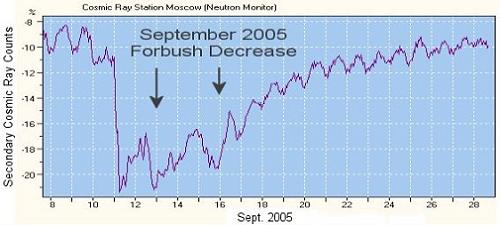Surprisingly, solar activity may benefit astronauts
Ariel Eisenhandler

Direct link to this page: https://www.hayadan.org.il/solar171005.html
Last month the sun "went out of its mind". At the beginning of September, almost every day for about two weeks, eruptions arose from a huge sunspot called "active region 798/808". X-rays ionize the upper layer of the atmosphere. Protons "scorched" the moon. It wasn't an ideal time to be in space... or was it?
A very strange thing happened aboard the International Space Station (ISS) during these solar storms: radiation levels dropped. "The station crew absorbed about 30% less cosmic radiation than in a normal situation," says Frank Cucinotta, the health officer responsible for radiation at the Johnson Space Center, NASA. "The storms actually improved the radiation environment inside the station."
This phenomenon is no stranger to scientists. It is called "Forbush decrease", after the American physicist Scott A. Forbush, who studied cosmic rays in the 30s and 40s. When cosmic rays hit the upper layer of the atmosphere, they create a shower of secondary particles that can reach the ground. By measuring these particle showers, Forbush found, contrary to common sense, that the amount of cosmic rays decreases when the sun's activity increases.
The reason is simple: when sunspots erupt they throw massive clouds of hot gas from the sun. These clouds (which are called CME: Coronal Mass Ejections) contain, in addition to hot gas, magnetic force fields (loops of magnetism that are torn from the Sun by the explosion). Magnetic fields deflect charged particles from their orbits, so that when a CME cloud passes over Earth it also "sweeps" many of the electrically charged cosmic rays that would otherwise hit our planet. This is the "Forbush reduction". No matter where the CME clouds pass, cosmic rays are deflected from their path. Forbush reduction has already been observed in the past on NASA as well as in orbit around it on the Mir spacecraft and the International Space Station. The spacecraft Pioneer 10 and 11 and Voyager 1 and 2 also experienced the phenomenon, beyond the orbit of Neptune.
A single CME cloud can stop cosmic rays for several weeks. Prolonged sun activity can stop them for a much longer period. "The year 2005 was a surprising year in regards to activity on the Sun," notes Cuccinotta. Since January 2005, astronomers have counted 14 strong X-type bursts and an even larger number of CME clouds. As a result, "the crew of the International Space Station absorbed fewer cosmic rays throughout the year."
This whole story is ironic because solar flares and CME clouds are themselves a source of deadly radiation, especially CME clouds which cause proton storms. On its way to Earth, a CME cloud passes through the outer atmosphere of the Sun, leveling its way through boiling gas at speeds exceeding one million miles per hour (about one million six hundred kilometers per hour). Protons caught in the path of such a CME cloud can be accelerated to dangerous energies. No astronaut wants to encounter a swarm of high-energy protons from the Sun. Severe storms cause disease; Exposure to them causes vomiting, fatigue and low blood count. An astronaut suffering from radiation damage may die without medical treatment. And the good news: very few such protons can penetrate the body of NASA's spacecraft, so as long as the astronauts are inside the spacecraft, they are protected.
Cosmic rays are different - and worse. Cosmic rays are highly charged subatomic particles and come mainly from outside the solar system. Among the sources of these rays are exploding stars, black holes and other features that dwarf the sun's violence. While the protons from the sun can be easily blocked by materials such as aluminum or plastic, there is no known shielding technology that can completely stop cosmic rays. Even inside the spaceships, astronauts are exposed to a slow trickle of cosmic rays, which penetrate straight through the body of the spaceship. The particles penetrate the meat and cause tissue damage at the microscopic level. One side effect is DNA. broken, which over time can cause cancer, cataracts (eye disease) and other diseases.
No one knows all the things that cosmic rays can do to humans. "We haven't been in space long enough," says Cuccinotta and explains: with the exception of short trips to the moon 40 years ago, astronauts have not been fully exposed to galactic cosmic rays. In the vicinity of the ISS, in the orbit of the International Space Station, the station crews are protected in addition to the body of the station by the ISS's magnetic field and the solid and huge body of the ISS itself. A six-month journey to Mars away from these natural shields is a completely different story: what are the long-term risks? How much protection do astronauts need to stay safe? NASA researchers are struggling with these questions. One thing is clear, "reducing exposure (to radiation) is a positive thing," says Cuccinotta.
The sun can help with this. Every 11 years, the sun's activity reaches a peak called "Solar Max". The last time it happened was in 2000 and in the future it is expected to happen in 2011 and 2022. During solar maximum, CME clouds are produced on a daily basis and the solar wind spreads loops of magnetic fields towards the interior of the solar system frequently. These fields provide an additional protective measure for trips to the Moon and Mars, by reducing 30% of cosmic ray fluxes in the biologically dangerous energy range: MeV 100 to MeV 1000 (MeV – million electron volts). It is possible that future voyage planners will time long journeys in the solar system to roughly coincide with solar maximum, thereby benefiting from the decline in cosmic rays.
So don't let them work on you: maybe solar flares aren't bad after all!
For information on the NASA website
The solar knower
https://www.hayadan.org.il/BuildaGate4/general2/data_card.php?Cat=~~~293956718~~~12&SiteName=hayadan
